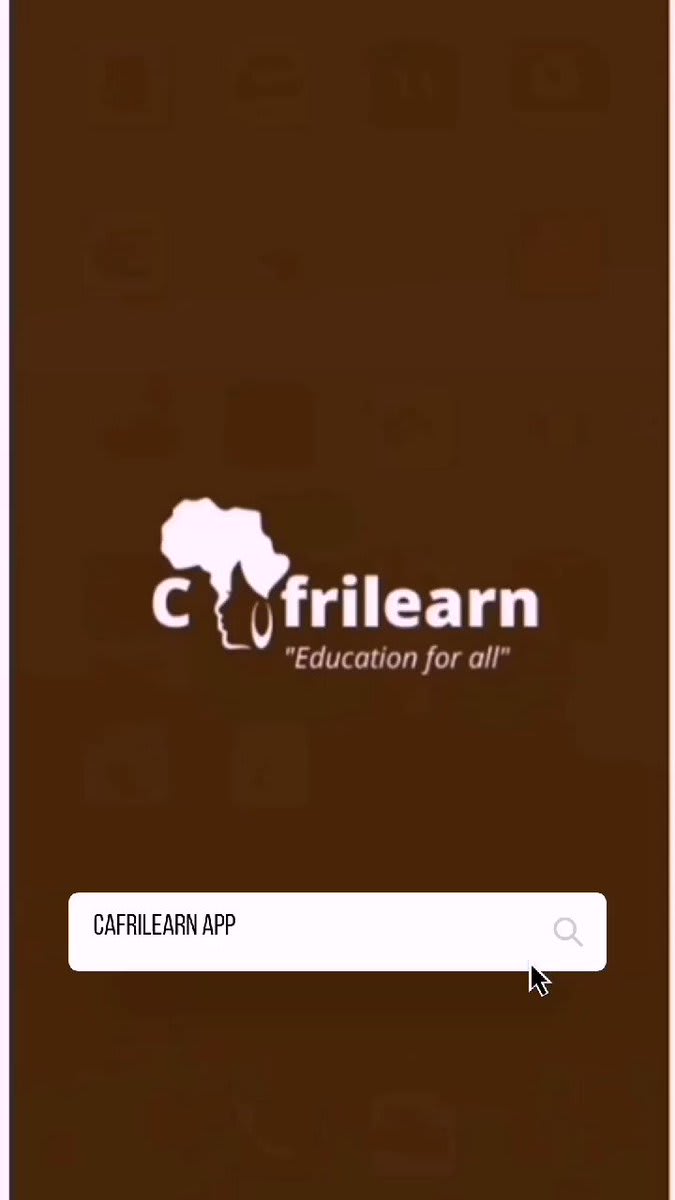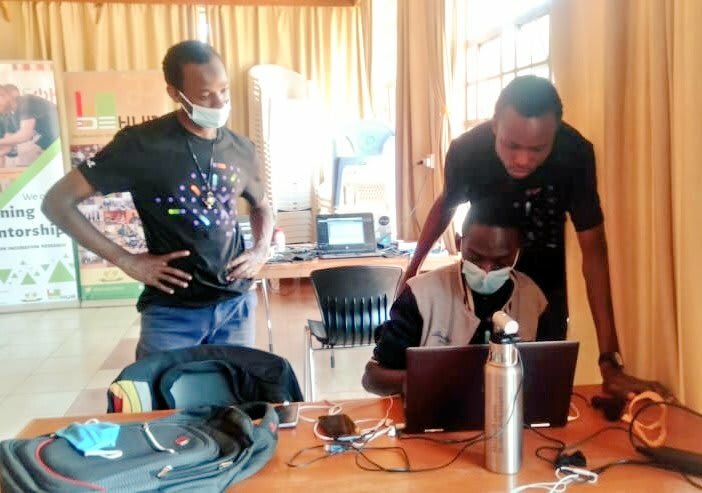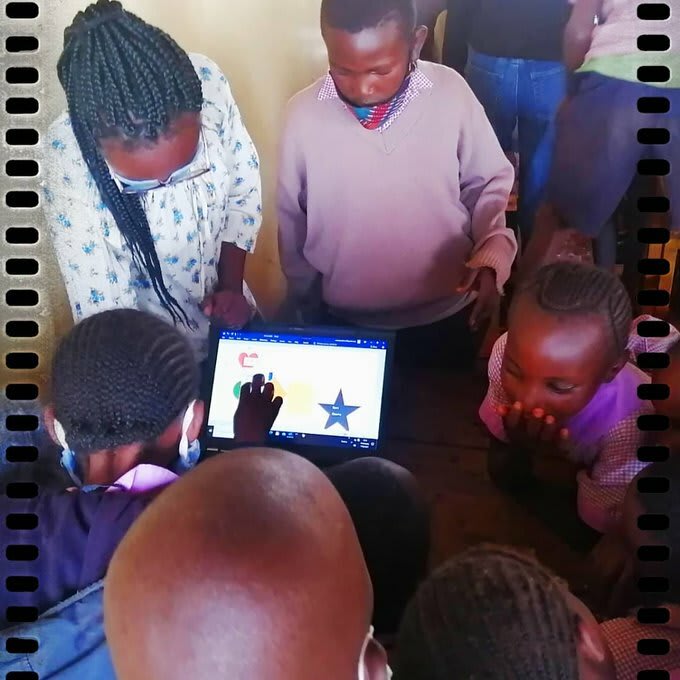On this next showcase on Microsoft Imagine Cup Community Kenya, we'll be highlighting two members from a team among the 2021 Imagine Cup World Finalists - Team Cafrilearn. They are a team of four from the Dedan Kimathi University of Technology namely:
- Humphry Shikunzi - Fullstack Developer, co-founder, in charge of managing the general app infrastructure and also a Microsoft Learn Student Ambassador.
- Clinton Oduor - IoT enthusiast.
- Lillian Patience - Team Manager, specialized in the hardware and a Microsoft Learn Student Ambassador.
- Collins Emasi - majors in Machine learning and App development
Bethany: What's Team Cafrilearn all about?
Lillian: Cafrilearn is a team that built a project to help children, especially from marginalized communities with no access to the internet and live in areas with low electricity penetration. We created Makini - an offline learning device that allows for an interactive session at a low cost. Through the device, students can have access to learning materials through speech without relying on the internet.
Bethany: What technologies do you use to ensure that students get access to learning materials offline?
**Lillian: The majority of our platform is majorly on Microsoft Azure. Since storage is actually our main focus, we're using Azure Blob Storage because we have to store most of our material there. We're also making use of data analytics to be able to get feedback from the device when it's in use and adjust our product accordingly.
Bethany: How does Makini work?
Humphry: Well, we've also used Microsoft Azure to host the website itself, the APIs, the databases and blob storage that Lillian mentioned. What motivated us initially was that we wanted to avail materials to students living in remote areas. All that is required is a teacher with a smartphone to log into the mobile app and download the learning materials then share via Bluetooth to the device. The students can then interact with Makini or someone can read out the content out loud.
We then get feedback from the students through the device and this information gets stored in our databases and from there on, know how to improve our device.


 Cafrilearn@cafrilearn
Cafrilearn@cafrilearn Here's a small snippet of what Cafrilearn is all about😃
Here's a small snippet of what Cafrilearn is all about😃
#education4all #elearning #imaginecup #technology #MicrosoftEDU #Kenyatotheworld
@DeKUTkenya @MSFTImagine @ImagineCupKE05:30 AM - 16 Mar 2021
Bethany: How did you conduct market research for the product?
Lillian: As the Team Manager, I was playing multiple roles within, one of them being market research. I went ahead to form a partnership with a local school around our area called Moringa II Primary School. Not only did we get incite from teachers on the product, but we also tested the device with the children themselves to properly get feedback on the same. That allowed us to create a better product and help in terms of the business aspect and marketability.
Bethany: What's the current or future impact of your product?
Lillian: From the market research, we could clearly see that our product was an avenue that was yet to be explored. Yes, there have been tablets and other bridges to create a link between children and access to education, but most of them tend to rely on internet connectivity. In reality, a lot of people in Kenya, Africa and beyond, don't have access to the internet and even in some places, electricity penetration. As such, we believe our project is very viable. We're looking forward to creating a better prototype and launching it through our start-up.
Bethany: What are the skills required to launch your product?
Humphry: We needed a mobile app developer for the teachers to gain access to the learning materials. We also needed skills to develop APIs used to manage our users and also access information. For the main device used by the students, we required some skills in electronics and firmware. We got lucky because most of us are electrical engineers, and we could build the whole pipeline from end to end.
We also got help with marketing from one of our managers - Mr. Ken. He was the one who helped us with the marketing design and how to work as a team towards building a product that'd be viable for the end-user.
Bethany: How has MLSA and Imagine Cup program contributed to your product?
Humphry: After passing the first round of the competition and joining the World Championship, we were given access to resources like Azure Cloud credits for building our start-up.
Lillian: Participation in the Imagine Cup has helped our project get more attention and traction. We've also gained more insight into our process's strengths and understand the potential of our project. In addition to attending the Imagine Cup challenge, we've become more motivated and gained exposure as a team, and gain insight on how to make our product better. Making it past the first round was also a huge achievement for us.
Bethany: What challenges did you face while working during the COVID pandemic and how did you respond to them?
Lillian: When you're dealing with hardware during the pandemic, it's a bit hectic to work with people in different locations performing different roles. Linking them simultaneously to form a pipeline that actually works is difficult because there are deadlines to be met and sacrifices to be made to make up for the time that we have. Especially when we were participating in the Imagine Cup, there were times when we could sleep very late because we'd be working on all the things that were required.
I'd say one of the greatest tasks that came with COVID would be working as a team - teamwork is very important and each member being able to deliver on their tasks. In this pandemic, you can't work properly and complete a project on time unless everyone plays their part as they should be and are willing to work towards the main team objective. The best part of our team is that we're diverse in what we can do and that helped us work together and create a pipeline to work properly.
Bethany: What's one thing you regret doing in your project and how did you overcome it?
Humphry: I don't regret anything because it was the first time we were doing this. However, I'd advise anyone who'd want to build a similar product from scratch, not to repeat the same mistakes we did. The materials we used are supposed to be stored in blob storage for teachers to download them and share via Bluetooth with the device for the students to interact with it. Everyone was searching for learning materials from different websites we could find. After going through all that, we realized that you must be certified by bodies like the Ministry of Education or the Kenya Institute of Curriculum Development(KICD) to relay such materials to students or any learning institutions. Therefore, this meant that although we'd gotten valid learning material, we weren't permitted to use it.
So, if you're doing such a thing, try to look for 2 or 3 materials just to test if your product works, and then start partnering with relevant education bodies. That was one of the things we spent a lot of time working on at the beginning of the project although it was unnecessary.
Another thing was preparation for making presentations at the Imagine Cup. If it's possible, try doing the presentations when everyone is in the same location. PRACTICE! PRACTICE! PRACTICE! Do this as much as possible to be prepared for any questions you might be asked.
Bethany: What were the most exciting moments while creating the project and also during the Imagine Cup Competition?
Humphry: I enjoy the thrill of programming and building things - seeing all those lines of code on your screen and at the end of it, compiling code that runs. Also, I enjoyed working with a dedicated team that's very skilled in what they're doing. I got to see their potential, something I had never seen before despite some of us being classmates.
When we were selected for the Imagine Cup World Finals, we saw that we were competing with teams from Japan, Canada, Turkey and such. That brought our team and our whole university to a global level and I'd like to continue experiencing this - doing things at a global level.
Lillian: For me, the first one would be when our participation in AU Africa was confirmed, that was the first platform we ever presented our project to. It was a nice opportunity and I was excited because it showed the potential for what we were doing.
The second one would be when our program first ran. It's such an intense feeling to see your idea finally come to life and in action. It's a feeling that can't be compared to anything else.
The other part was seeing how the children responded to our product; it was so amazing. They were so excited, asking Makini questions to give them information. It felt like we were really doing something huge for them.
Bethany: How soon can we expect to see Makini on the market?
Lillian: Currently, the devices we have aren't that many and we're still working on them and doing test runs with students. We're also trying to finish up on some tweaks needed in order to be sure of when the final product will be launched.
Bethany: Do you have funding for your project?
Humphry: We haven't started looking for funding for the project yet because we're still doing Beta tests on the hardware and software to get it to the next level. However, we still have plans in place to look for funding when the time comes.
Bethany: How has your process been?
Humphry: During the COVID lockdown in September 2020, the whole team was working remotely from different locations. Fortunately, the restrictions were lifted, we went back to school and started working on the mobile and web apps. Then, we ordered some hardware on Amazon before returning home for Christmas. We then assembled everything in January after the delivery, wrote the firmware, and integrated the whole pipeline for the device.
Right now, we're in the process of improving the systems in charge of interactivity in terms of cognitive services and getting feedback from the students and teachers. We've been trying to improve the UI of our applications and adding some features. We plan to continue testing our product with students once they get back in session. We also want to partner with authorized local content providers to help us get good learning material that' up to standard and within the legal bounds.
Bethany: What's your parting shot for students wanting to get into hackathons?
Lillian: Once you've created your product or your idea, that's a manifestation of your intellect, your skill, your everything. Don't be afraid to give it a go at many competitions. There are situations where we apply but don't get in or you don't win; it's all part of the process. But at the same time, you gain more experience.
I'd like to encourage more people to participate in the Microsoft Imagine Cup, you'll get access to so much like field experts to give you advice. It opens up a world of opportunities that you would otherwise not have been able to get. You also get perks like Azure credits to further develop your product. Believe in your product, trust in it and give it a go!
Humphry: If you want to build something successful from scratch, you should look at the main objective. For us, we are solving a problem. Look at your surroundings and choose a problem that you can focus on and solve.
Then, build a team of about 2 to 3 people to help you with development; it's hard to do everything alone. Look for dedicated teammates, people who won't stop attending your meetings after the third day or won't get preoccupied with other things.
Also, find potential customers for your solution to test it out. Nurture a relationship with them to get their feedback. After you've built the first version, it doesn't need to be working perfectly because you won't have all the requirements and resources. When the first version of Windows was brought into the market, it wasn't a complete product. It had bugs and could occasionally crash but they improved on it over time. Just start with what you have and keep on improving on it.
Show us some love:
You can watch the full interview on the MLSA Kenya YouTube channel. We'd like to thank Team Cafrilearn for accepting our interview. Be sure to follow them on Twitter @cafrilearn.












Top comments (0)